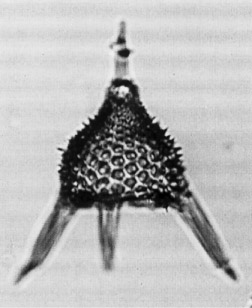 Lychnodictyum
audax Riedel
Lychnodictyum
audax Riedel Lychnodictyum
audax Riedel
Lychnodictyum
audax RiedelLychnodictyum audax Riedel, 1953, p.810, pl.85, fig.9; Sanfilippo and Riedel, 1974, p.1022, pl.2, fig.8
Shell campanulate, with rough surface and distinct collar stricture. Length of the two joints 1:4, breadth 1:5. Cephalis subspherical, with rather few, subcircular, well-separated pores, bearing a conical horn of the same to twice the length, which has short, obtusely conical protuberances in its distal portion. Thorax subglobular, with rough ridges between the large rounded pores, which are 2-5 times as broad as the intervening bars. Peristome constricted, the feet arising slightly above the margin. Feet of approximately the same length as the thorax, triangular pyramidal with pronounced blades, fenestrated in the proximal portion, almost straight, divergent. Small spines are often present on the lower edge of the thorax as if remnants from a reduced abdomen (Riedel, 1953).
Length of the apical horn 35-50 µm; of the cephalis 24-28 µm; of the thorax 90-105 µm; of the feet 75-110 µm. Breadth of the cephalis 25-30 µm; of the thorax 110-130 µm; of the thoracic pores 4-12 µm (Riedel, 1953).
Thorax plus cephalis 85-130 µm long; thorax 95 (rarely 80)-130 µm wide (Sanfilippo et al., 1985).
The three feet arising from the base of the thorax are almost straight, widely divergent, and latticed proximally. Horn prominent, thorny distally (Riedel and Sanfilippo, 1978a).
This species differs from Pterocanium trilobum (Haeckel, 1860, p.839; Nigrini, 1967, p.71, pl.7, figs.3a-3b) by the thorns on the horn (Sanfilippo et al., 1985).
This two-segmented theoperid has a campanulate, rough-surfaced shell, three divergent, bladed legs that are fenestrated proximally, and a stout horn, which is thorny distally. Occasionally, remnants of a skirt of meshwork hangs from the peristome. Some specimens from high-latitude sites have thorns on the surface of the thorax, and poorly developed protuberances on the horn (Sanfilippo et al. 1985).
L. audax is found in all oceans, in middle Oligocene through early Pliocene samples from latitudes lower than 40°. Its morphotypic first appearance lies within the Theocyrtis tuberosa Zone. Its morphotypic last appearance lies within the Spongaster pentas Zone.
Lychnodictyum audax extends as far back in time (to the middle Oligocene) as any of the other two-segmented theoperids with three feet latticed proximally (members of the genera Lychnodictyum and Pterocanium in the sense of Haeckel, 1887). In the early part of its range, all members of this group are rare and sporadic in their occurrence, so that it is difficult to determine their ancestry. Very rare specimens in DSDP 77B-46-6 and -47-2 have an outwardly-directed thorn proximally on each foot, suggesting a relationship to the late Eocene Lychnocanium tridentatum Ehrenberg (1873, p.244; 1875, pl.7, fig.4), but on the other hand Lychnodictyum audax and the other members of the Lychnodictyum - Pterocanium group may equally well have originated from one of the abundant late Eocene or early Oligocene species of Lychnocanium with imperforate feet (Sanfilippo et al., 1985).
Although this species is evidently closely related to stratigraphically useful forms such as Pterocanium prismatium, it is not now transferred to that genus because of uncertainty regarding the nature of the figured type species of Pterocanium (Lithocampe aculeata Ehrenberg, according to Foreman and Riedel, 1972) (Sanfilippo and Riedel, 1974).
We agree in principle with Lazarus et al., 1985 that Lychnodictyum audax and its probably descendant, Pterocanium trilobum (see Nigrini, 1967, p.71, pl.7, figs.3a-3b) belong in the same genus. However, since L. audax may well be the ancestral stock, we hesitate to use their synonym until the entire lineage has been examined (Caulet et al., 1993).